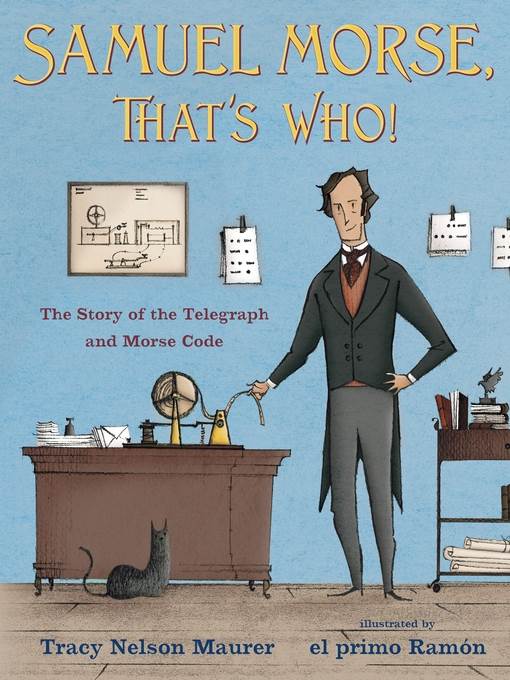
Samuel Morse, That's Who!
The Story of the Telegraph and Morse Code
فرمت کتاب
ebook
تاریخ انتشار
2019
Lexile Score
700
Reading Level
2-3
ATOS
4.1
Interest Level
K-3(LG)
نویسنده
El Primo Ramónشابک
9781250618399
کتاب های مرتبط
- اطلاعات
- نقد و بررسی
- دیدگاه کاربران
نقد و بررسی

May 6, 2019
In a frank, upbeat style, Maurer conveys to young digital natives what it meant to communicate via telegraph: “In the early 1800s, nothing traveled long distances fast. So, who would dream of instant messages? Samuel Morse, that’s who!” Appearing in Ramón’s charcoal-lined mixed-media art as a nondescript gentleman in a tailcoat, Morse strives unsuccessfully to become an artist before beginning to tinker with what would become the first electromagnetic telegraph machine. After disastrous attempts to lay cable in New York Harbor, success came in the form of above-ground telegraph lines. While back matter provides a timeline and additional facts relating to the telegraph, readers may still have questions about the technology and Morse Code. Still, the key takeaway, that the most innovative new technologies begin with a spark of imagination, is sound. Ages 4–8.

June 1, 2019
Gr 1-2-Who makes a great topic of a picture book biography? Samuel Morse, that's who! Maurer tells the story of Morse's invention of the telegraph and Morse code in an engaging, light text. Pencil-line drawings with digital coloring by Ramón convey a strong sense of time and place, and the heavy use of white space makes the layout appealing for young readers. Maurer begins by emphasizing some of Morse's failed endeavors, including unsuccessful inventions and his passion to become an artist. While Morse enjoyed painting, he was never critically successful; however, in his travels to become a better artist, he discovered the French optical telegraph system, which inspired the telegraph and Morse code. He eventually turned his focus to his invention and the development of a U. S. telegraph line. The simple text provides relevant connections for students in its portrayal of great success spawned from failure and revision of plans and ideas. Endpapers include a time line of Morse's life, facts about the telegraph, an extensive bibliography, and an author's note that connects Morse's code to the modern binary language of computers. VERDICT This is an excellent biography on a lesser-known figure; add to collections looking for inventors and makers. As it turns out, ... amuel M - - - r ... e was a predecessor of the maker movement.-Jamie Jensen, Wayne Cox Elementary School, Roanoke, TX
Copyright 2019 School Library Journal, LLC Used with permission.

April 15, 2019
"Who created instant messages and changed the world forever?" Lively, fact-based text and energetic, kid-friendly illustrations capture the feeling of a past era to present the story of frustrated artist and creative inventor Samuel Morse. Setting the scene quickly so youngsters can jump right in, Maurer good-naturedly portrays Morse's artistic snobbery and vision, his not-so-successful experiments with invention, his interest in innovation, his willingness to take risks, his inquiring mind, and his resilience, presenting her subject as a real person to identify with rather than a flawless hero to be coolly admired. This is not a tale of diversity; the cast of characters is primarily male and white, though there are some women and people of color in the background. Periodic questions about Morse's ideas appear within the story, clarifying Morse's historical role and allowing for the repeated, titular refrain: "Samuel Morse, that's who!" By breaking down the invention of the telegraph into steps that readers will easily understand, the text effectively explains how the invention works as well as how it came to be, and young readers and listeners just may be inspired to try some inventing of their own. Backmatter includes a timeline, bibliography, additional facts, and an author's note. For readers who are able to remove the jacket, there is a Morse code chart on its reverse. An excellent, entertaining choice to highlight social-emotional skills, history, and STEM. (Picture book/biography. 5-8)
COPYRIGHT(2019) Kirkus Reviews, ALL RIGHTS RESERVED.

June 1, 2019
Grades 1-3 Samuel Morse wasn't quite an instant success. He wanted to be a painter, but when his career in America didn't take off, he sailed to England in 1829 to study. People still didn't seem to get his art when he returned, but they sure were interested in the electromagnetic system to carry coded messages that he'd designed on the voyage home . It took trial and lots of error, but eventually Morse developed Morse code and the telegraph, allowing news that had previously taken months to travel across countries in a blink. Maurer follows up her noted John Deere, That's Who! (2017) with another accessible exploration of an instrumental figure in STEM. Ram�n's illustrations, sometimes tongue-in-cheek, complement the breezy tone as they map Morse's journey. The extensive back matter includes a time line and additional resources, and readers curious about Morse code, discussed briefly in the text, should check under the book's jacket (a feature that may be lost in libraries if the jacket is laminated down). A fun, informative way to tap into historical inventions.(Reprinted with permission of Booklist, copyright 2019, American Library Association.)

























دیدگاه کاربران